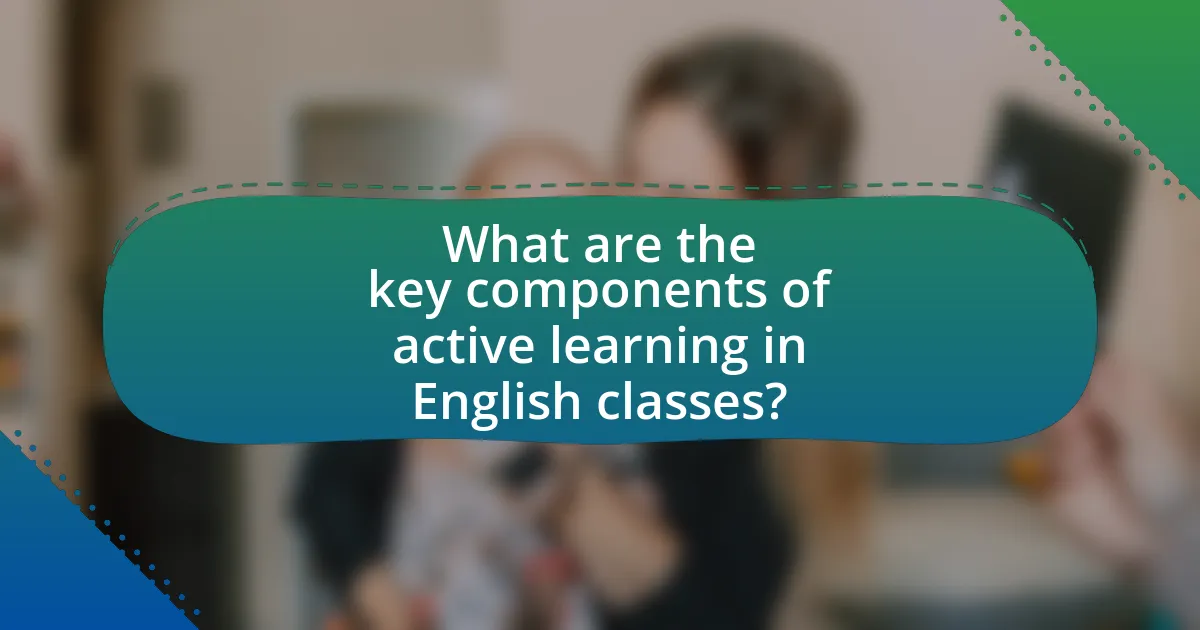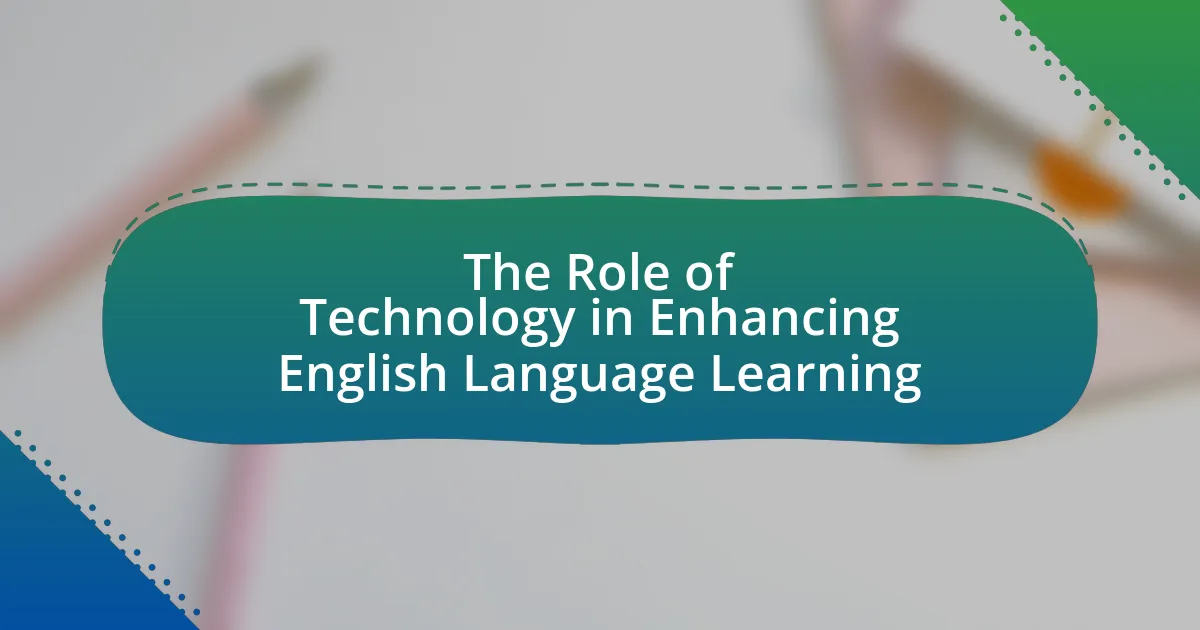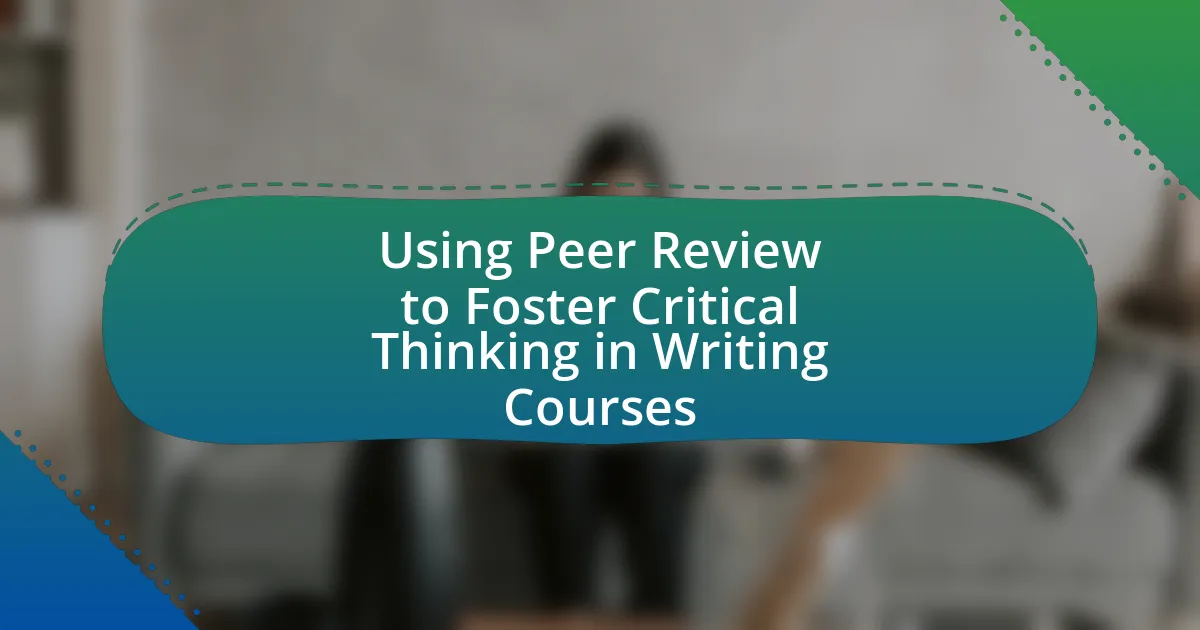The article examines the impact of active learning on student engagement in English classes, highlighting how interactive participation and critical thinking enhance motivation and information retention. Research indicates that active learning strategies, such as collaborative learning and problem-based learning, significantly improve student performance and engagement compared to traditional lecture-based methods. Key components of active learning, including technology integration and group discussions, are discussed, along with the benefits of high student engagement in language acquisition. The article also addresses challenges educators face in implementing active learning and offers strategies to overcome resistance and assess effectiveness.

What is the Impact of Active Learning on Student Engagement in English Classes?
Active learning significantly enhances student engagement in English classes by promoting interactive participation and critical thinking. Research indicates that when students actively engage in their learning process through discussions, group work, and hands-on activities, they demonstrate higher levels of motivation and retention of information. A study published in the Journal of Educational Psychology found that classrooms employing active learning strategies saw a 20% increase in student engagement metrics compared to traditional lecture-based approaches. This evidence supports the conclusion that active learning fosters a more dynamic and participatory learning environment, leading to improved student outcomes in English classes.
How does active learning influence student participation in English classes?
Active learning significantly enhances student participation in English classes by promoting engagement through interactive and collaborative activities. Research indicates that when students actively participate in their learning process, such as through group discussions, peer teaching, and hands-on projects, they are more likely to retain information and develop critical thinking skills. A study by Freeman et al. (2014) published in the Proceedings of the National Academy of Sciences found that active learning methods can increase student performance by 6% on average compared to traditional lectures. This evidence supports the notion that active learning fosters a more dynamic classroom environment, leading to higher levels of student involvement and motivation in English language learning.
What specific active learning strategies enhance student engagement?
Specific active learning strategies that enhance student engagement include collaborative learning, problem-based learning, and the use of technology in the classroom. Collaborative learning encourages students to work together, fostering communication and teamwork skills, which has been shown to increase motivation and participation. Problem-based learning engages students in real-world scenarios, prompting critical thinking and application of knowledge, thereby enhancing their investment in the learning process. Additionally, integrating technology, such as interactive simulations and online discussion forums, allows for diverse learning experiences and immediate feedback, which can significantly boost student interest and involvement. Research indicates that these strategies lead to higher levels of student engagement and improved academic outcomes, as evidenced by studies showing that classrooms employing active learning techniques report increased student satisfaction and retention rates.
How do students perceive active learning compared to traditional methods?
Students generally perceive active learning more positively than traditional methods, as it fosters greater engagement and participation. Research indicates that active learning strategies, such as group discussions and hands-on activities, enhance students’ motivation and retention of information compared to passive learning environments, where students primarily listen to lectures. A study by Freeman et al. (2014) published in the Proceedings of the National Academy of Sciences found that students in active learning settings performed better on exams and had lower failure rates, demonstrating the effectiveness of these methods in improving educational outcomes.
Why is student engagement important in English classes?
Student engagement is crucial in English classes because it enhances learning outcomes and fosters critical thinking skills. Engaged students are more likely to participate actively in discussions, leading to deeper comprehension of the material. Research indicates that when students are actively involved, they retain information better; for instance, a study published in the Journal of Educational Psychology found that active learning strategies can increase student performance by up to 20%. This demonstrates that high levels of engagement not only improve academic achievement but also promote a positive attitude towards learning, making it essential for effective English instruction.
What are the benefits of high student engagement in language learning?
High student engagement in language learning significantly enhances language acquisition and retention. Engaged students are more likely to participate actively in discussions, practice speaking, and apply new vocabulary, leading to improved fluency and comprehension. Research indicates that active engagement can increase retention rates by up to 75%, as students who are involved in their learning process tend to remember information better than those who are passive learners. Furthermore, high engagement fosters motivation and a positive attitude towards learning, which are critical for overcoming challenges in language acquisition.
How does engagement affect language acquisition and retention?
Engagement significantly enhances language acquisition and retention by fostering active participation and emotional investment in the learning process. When learners are actively engaged, they are more likely to practice language skills, which leads to better comprehension and memory retention. Research indicates that students who participate in interactive activities, such as discussions and collaborative projects, demonstrate improved language proficiency compared to those who engage in passive learning methods. For instance, a study by Chi and Wylie (2014) published in the journal “Educational Psychologist” found that active learning strategies can increase retention rates by up to 50%. This evidence underscores the critical role of engagement in facilitating effective language learning outcomes.

What are the key components of active learning in English classes?
The key components of active learning in English classes include student engagement, collaborative learning, and experiential activities. Student engagement is fostered through interactive discussions and hands-on tasks that encourage participation. Collaborative learning involves group work and peer feedback, which enhances communication skills and critical thinking. Experiential activities, such as role-playing and simulations, allow students to apply language skills in real-world contexts, reinforcing their understanding and retention of material. Research indicates that these components significantly improve student motivation and academic performance in language acquisition.
What types of active learning techniques are commonly used?
Commonly used active learning techniques include think-pair-share, problem-based learning, and collaborative group work. Think-pair-share encourages students to think about a question individually, discuss their thoughts with a partner, and then share with the larger group, promoting engagement and critical thinking. Problem-based learning involves students working on real-world problems, enhancing their analytical skills and teamwork. Collaborative group work allows students to learn from each other, fostering communication and social skills. Research indicates that these techniques significantly improve student engagement and learning outcomes in educational settings.
How do group discussions contribute to active learning?
Group discussions significantly enhance active learning by fostering collaboration and critical thinking among students. In these discussions, learners engage with diverse perspectives, which promotes deeper understanding and retention of material. Research indicates that collaborative learning environments, such as those created through group discussions, lead to improved academic performance and increased motivation. For instance, a study published in the Journal of Educational Psychology found that students participating in group discussions demonstrated higher levels of engagement and comprehension compared to those who learned individually. This evidence supports the assertion that group discussions are a vital component of active learning, as they encourage interaction, reflection, and the application of knowledge in a social context.
What role do interactive activities play in enhancing engagement?
Interactive activities significantly enhance engagement by actively involving students in the learning process. These activities, such as group discussions, role-playing, and hands-on projects, promote collaboration and critical thinking, which are essential for deeper understanding. Research indicates that students participating in interactive learning environments demonstrate higher levels of motivation and retention of information. For instance, a study by Prince (2004) found that active learning strategies can increase student performance by up to 50% compared to traditional lecture-based approaches. This evidence underscores the effectiveness of interactive activities in fostering a more engaging and productive educational experience.
How can technology facilitate active learning in English classes?
Technology facilitates active learning in English classes by providing interactive tools that enhance student engagement and participation. For instance, platforms like Google Classroom and Kahoot enable real-time feedback and collaborative activities, allowing students to actively participate in discussions and assessments. Research by the Educause Review indicates that technology integration in classrooms leads to a 20% increase in student engagement levels, demonstrating its effectiveness in fostering an interactive learning environment. Additionally, multimedia resources such as videos and podcasts cater to diverse learning styles, further promoting active involvement in language acquisition.
What digital tools are effective for promoting active learning?
Digital tools effective for promoting active learning include interactive platforms like Kahoot, Google Classroom, and Padlet. Kahoot engages students through gamified quizzes, enhancing participation and retention, as evidenced by a study published in the Journal of Educational Technology & Society, which found that gamification increases student motivation and engagement. Google Classroom facilitates collaboration and organization, allowing students to engage in discussions and share resources, which has been shown to improve learning outcomes. Padlet serves as a collaborative space where students can contribute ideas and feedback in real-time, fostering a sense of community and active participation. These tools collectively support active learning by encouraging interaction, collaboration, and immediate feedback.
How does online collaboration impact student engagement?
Online collaboration significantly enhances student engagement by fostering interactive learning environments. Research indicates that collaborative online activities, such as group projects and discussions, increase participation rates and motivation among students. A study published in the Journal of Educational Psychology found that students who engaged in collaborative learning online reported higher levels of interest and satisfaction in their coursework compared to those who learned independently. This increase in engagement is attributed to the social presence and peer interaction that online collaboration facilitates, which can lead to deeper understanding and retention of material.

What challenges do educators face when implementing active learning?
Educators face several challenges when implementing active learning, including resistance from students, lack of training, and insufficient resources. Resistance from students often stems from their familiarity with traditional teaching methods, leading to discomfort with new approaches. Additionally, many educators lack adequate training in active learning strategies, which can hinder effective implementation. Insufficient resources, such as time, materials, and institutional support, further complicate the integration of active learning into curricula. These challenges can significantly impact the effectiveness of active learning in enhancing student engagement in English classes.
What are common barriers to active learning in English classes?
Common barriers to active learning in English classes include lack of student motivation, insufficient resources, and rigid curriculum structures. Lack of student motivation can hinder participation, as students may not see the relevance of active learning methods to their personal or academic goals. Insufficient resources, such as limited access to technology or materials, can restrict the implementation of interactive activities. Rigid curriculum structures often prioritize standardized testing over innovative teaching methods, making it difficult for educators to incorporate active learning strategies effectively. These barriers collectively impede the potential benefits of active learning, which has been shown to enhance student engagement and improve learning outcomes.
How can teachers overcome resistance to active learning methods?
Teachers can overcome resistance to active learning methods by providing clear explanations of the benefits and actively involving students in the learning process. Research indicates that when teachers articulate how active learning enhances critical thinking and retention, students are more likely to engage. For instance, a study by Freeman et al. (2014) found that active learning can increase student performance by 6% compared to traditional lectures. Additionally, incorporating student feedback and gradually introducing active learning techniques can help ease students into these methods, making them feel more comfortable and involved.
What strategies can be employed to manage classroom dynamics during active learning?
To manage classroom dynamics during active learning, educators can implement strategies such as establishing clear expectations, facilitating group work effectively, and utilizing formative assessment techniques. Establishing clear expectations helps students understand their roles and responsibilities, which can reduce confusion and enhance participation. Facilitating group work effectively involves assigning roles within groups and monitoring interactions to ensure equitable participation, which fosters collaboration and engagement. Utilizing formative assessment techniques, such as quick polls or feedback sessions, allows educators to gauge student understanding in real-time and adjust instruction accordingly, thereby maintaining a dynamic and responsive learning environment. These strategies are supported by research indicating that structured group interactions and ongoing assessment significantly enhance student engagement and learning outcomes in active learning settings.
How can educators assess the effectiveness of active learning?
Educators can assess the effectiveness of active learning by utilizing a combination of formative assessments, student feedback, and performance metrics. Formative assessments, such as quizzes and reflective journals, provide immediate insights into student understanding and engagement levels during active learning activities. Student feedback, gathered through surveys or discussions, offers qualitative data on their perceptions of the learning process and its impact on their engagement. Performance metrics, including grades and completion rates of assignments, can quantitatively measure the outcomes of active learning strategies. Research indicates that active learning can lead to improved academic performance; for instance, a meta-analysis by Freeman et al. (2014) found that students in active learning environments performed 6% better on exams compared to those in traditional lectures. This evidence supports the effectiveness of active learning in enhancing student engagement and learning outcomes.
What metrics can be used to measure student engagement?
Metrics that can be used to measure student engagement include attendance rates, participation in class discussions, completion rates of assignments, and the frequency of interactions with course materials. Attendance rates indicate how often students are present, while participation in discussions reflects their willingness to engage with the content and peers. Completion rates of assignments demonstrate students’ commitment to their learning, and interactions with course materials, such as time spent on learning platforms or resources, provide insight into their active involvement. Research shows that higher attendance and participation correlate with improved academic performance, reinforcing the validity of these metrics in assessing engagement levels.
How can feedback be utilized to improve active learning practices?
Feedback can be utilized to improve active learning practices by providing students with specific, actionable insights that enhance their understanding and engagement. When instructors deliver timely feedback on student performance, it helps identify areas for improvement and reinforces effective strategies. Research indicates that feedback can increase student motivation and self-efficacy, leading to deeper engagement in learning activities. For instance, a study by Hattie and Timperley (2007) in “Review of Educational Research” highlights that feedback significantly influences student achievement when it is clear, constructive, and focused on the task rather than the individual. This evidence supports the notion that effective feedback is crucial for refining active learning practices and fostering a more engaging educational environment.
What best practices can enhance the impact of active learning on student engagement?
Best practices that can enhance the impact of active learning on student engagement include incorporating collaborative group work, utilizing technology effectively, and providing timely feedback. Collaborative group work fosters peer interaction, which has been shown to increase motivation and retention of information, as evidenced by a study published in the Journal of Educational Psychology, where students engaged in group activities demonstrated higher engagement levels compared to traditional lecture formats. Utilizing technology, such as interactive simulations and online discussion forums, can further engage students by making learning more dynamic and accessible. Additionally, providing timely feedback helps students understand their progress and areas for improvement, which is crucial for maintaining engagement; research from the National Bureau of Economic Research indicates that timely feedback significantly enhances student performance and motivation.
How can teachers design effective active learning experiences?
Teachers can design effective active learning experiences by incorporating collaborative activities, real-world problem-solving tasks, and technology integration into their lesson plans. Collaborative activities, such as group discussions and peer teaching, enhance student engagement by fostering communication and teamwork skills. Real-world problem-solving tasks, like case studies or project-based learning, allow students to apply their knowledge in practical contexts, making learning more relevant and motivating. Additionally, integrating technology, such as interactive simulations or online discussion forums, can facilitate active participation and provide diverse learning modalities. Research indicates that these strategies significantly improve student engagement and retention of information, as evidenced by a study published in the Journal of Educational Psychology, which found that active learning techniques increased student performance by up to 20% compared to traditional methods.
What role does reflection play in the active learning process?
Reflection plays a critical role in the active learning process by enabling students to analyze their experiences and integrate new knowledge. This self-assessment fosters deeper understanding and retention of material, as students critically evaluate what they have learned and how it applies to real-world contexts. Research indicates that reflective practices, such as journaling or group discussions, enhance cognitive engagement and promote metacognitive skills, which are essential for effective learning. For instance, a study published in the Journal of Educational Psychology found that students who engaged in reflective activities demonstrated improved academic performance and greater motivation in their studies.




